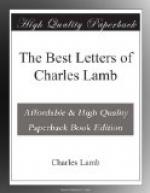But the epitaphs were trim and sprag, and patent, and pleased the survivors of Thames Ditton above the old mumpsimus of “Afflictions sore.” ... To do justice, though, it must be owned that even the excellent feeling which dictated this dirge when new, must have suffered something in passing through so many thousand applications, many of them no doubt quite misplaced, as I have seen in Islington churchyard (I think) an Epitaph to an Infant who died “AEtatis four months,” with this seasonable inscription appended, “Honor thy father and thy mother, that thy days may be long in the land,” etc. Sincerely wishing your children long life to honor, etc., I remain,
C. LAMB.
[1] Published in Coleridge’s “Friend,” Feb. 22, 1810.
LIII.
TO WORDSWORTH.
August 14, 1814.
Dear Wordsworth,—I cannot tell you how pleased I was at the receipt of the great armful of poetry which you have sent me: and to get it before the rest of the world, too! I have gone quite through with it, and was thinking to have accomplished that pleasure a second time before I wrote to thank you; but Martin Burney came in the night (while we were out) and made holy theft of it: but we expect restitution in a day or two. It is the noblest conversational poem [1] I ever read,—a day in heaven. The part (or rather main body) which has left the sweetest odor on my memory (a bad term for the remains of an impression so recent) is the “Tales of the Churchyard”—the only girl among seven brethren, born out of due time, and not duly taken away again; the deaf man and the blind man; the Jacobite and the Hanoverian, whom antipathies reconcile; the Scarron-entry of the rusticating parson upon his solitude,—these were all new to me too. My having known the story of Margaret (at the beginning), a very old acquaintance, even as long back as when I saw you first at Stowey, did not make her reappearance less fresh. I don’t know what to pick out of this best of books upon the best subjects for partial naming. That gorgeous sunset is famous; I think it must have been the identical one we saw on Salisbury Plain five years ago, that drew Phillips from the card-table, where he had sat from rise of that luminary to its unequalled setting. But neither he nor I had gifted eyes to see those symbols of common things glorified, such as the prophets saw them in that sunset,—the wheel, the potter’s clay, the washpot, the wine-press, the almond-tree rod, the baskets of figs, the four-fold-visaged head, the throne, and Him that sat thereon.




